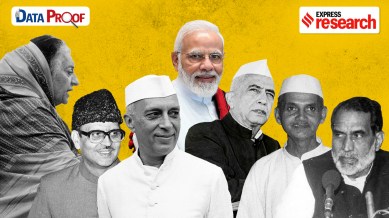Why Uttar Pradesh has given the highest number of PMs
UP is India's most populous state but numbers alone don't explain why it has produced so many of its Prime Ministers

There is a powerful role that numbers can play in narrating the life of a democracy. As India votes in the 18th Lok Sabha elections, we dig out some key numbers that have shaped the country’s electoral politics over the decades. Data Proof, a seven-part series, will tell the story of elections in India through numbers.
Since Independence, India has had 15 Prime Ministers, including the incumbent Narendra Modi.
monthly limit of free stories.
with an Express account.
Uttar Pradesh, constituting 17 per cent of India’s population (according to the 2011 census), has been the birthplace of six PMs. Moreover, nine PMs have represented Uttar Pradesh in the Lok Sabha, some from multiple constituencies. Punjab, including Pakistan Punjab, is at a distant second, with three PMs born in the state, followed by Gujarat with two.
If we look at the tenures of the PMs, the number is even more impressive. Among all the prime ministers who were in office, 75 per cent of the time, the office was held by a prime minister who concurrently served as a Member of Parliament from Uttar Pradesh. This includes the nearly 17-year tenure (6,130 days) of Nehru, cumulative tenure of over 15 years (5,829 days) of his daughter Indira Gandhi, six-year tenure of Atal Bihari Vajpayee (13 days in 1996, 13 months in 1998 and for five years from 1999), and the current Prime Minister, Narendra Modi, who has been in office since May 2014. While Modi was born in Gujarat, and subsequently became the Chief Minister of the state, he chose to contest elections from the Varanasi Lok Sabha constituency in 2014 and 2019.
Every Congress leader has represented Uttar Pradesh in the Lok Sabha during their time in the PM’s residence except PV Narasimha Rao (Andhra Pradesh) and Manmohan Singh, who was an MP for Rajasthan and Assam in the Rajya Sabha. While not all Congress PMs were born in Uttar Pradesh, they eventually ended up representing the ancestral state of Motilal Nehru, father of Jawaharlal Nehru.
The Nehru-Gandhi family has a long standing association with Uttar Pradesh, beginning when Motilal practiced law in Agra and later moved to Allahabad (now Prayagraj). He bought a large mansion in Allahabad named Swaraj Bhavan (earlier known as Anand Bhawan) which would serve as the informal meeting place for the All India Congress Committee. Jawaharlal Nehru and Indira Gandhi were both born in Allahabad and would reside at Swaraj Bhavan until 1930.
While the Nehru-Gandhi clan have consistently aligned with Uttar Pradesh, the state hasn’t always returned the favour. Indira was found guilty of electoral malpractice by the Allahabad High Court in 1975 and subsequently, in 1977, her party, the Congress (R) failed to win a single seat in the entire state. Indira and Rajiv both lost their seats in Raebareli and Amethi respectively, and Moraji Desai became PM.
So why is UP such an important political battleground?
For starters, it is India’s most populous state with 215 million people (2011 census). It also sends 80 members to the Lok Sabha – Maharashtra with 48 is a distant second. Members of Parliament from Uttar Pradesh account for 20 per cent of the Lok Sabha and a decisive victory in the state often determines who comes to power at the Centre. Uttar Pradesh was a Congress stronghold in the three decades after Independence, and tellingly, it was large swings in voter patterns in the state that led to the Congress’ first defeat in 1977 and the emergence of the BJP in the 1990s. In 2014, the BJP won a record 71 seats in UP, with a coalition ally winning another two. It went on to form the first parliamentary majority since 1984, when Congress won 83 of the 85 seats in UP at the time.
It is often said that the road to Delhi goes through UP. Based on what we’ve seen since 1952, one would be hard pressed to argue otherwise.